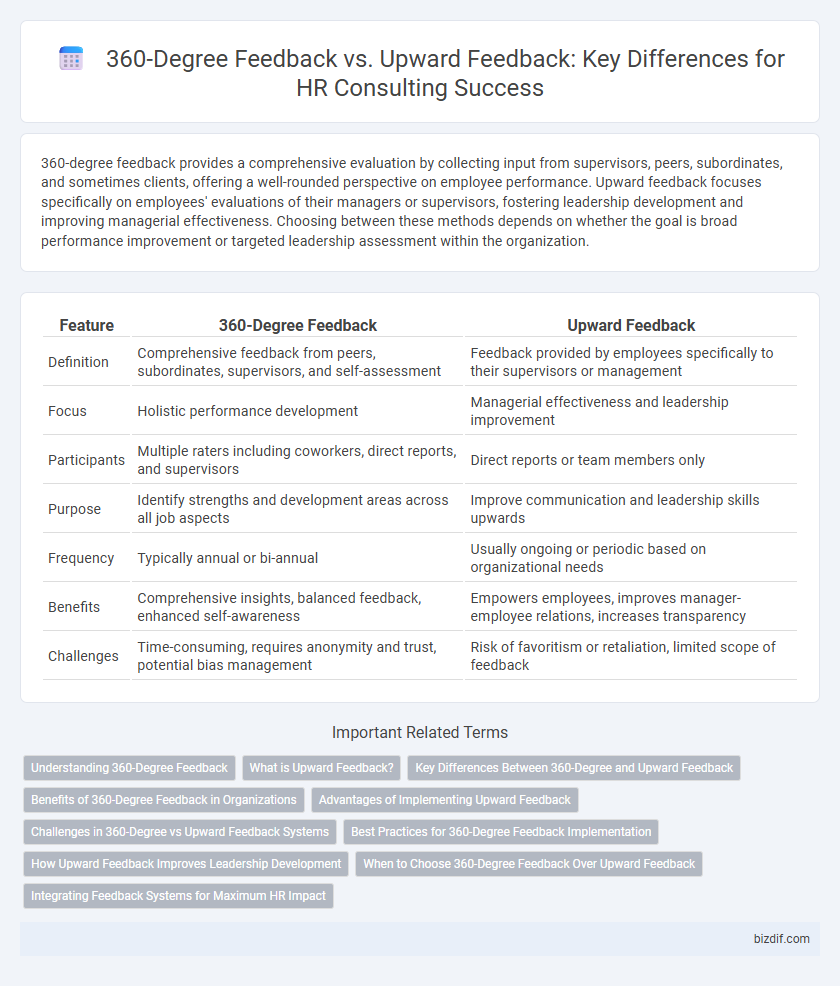360-degree feedback provides a comprehensive evaluation by collecting input from supervisors, peers, subordinates, and sometimes clients, offering a well-rounded perspective on employee performance. Upward feedback focuses specifically on employees' evaluations of their managers or supervisors, fostering leadership development and improving managerial effectiveness. Choosing between these methods depends on whether the goal is broad performance improvement or targeted leadership assessment within the organization.
Table of Comparison
| Feature | 360-Degree Feedback | Upward Feedback |
|---|---|---|
| Definition | Comprehensive feedback from peers, subordinates, supervisors, and self-assessment | Feedback provided by employees specifically to their supervisors or management |
| Focus | Holistic performance development | Managerial effectiveness and leadership improvement |
| Participants | Multiple raters including coworkers, direct reports, and supervisors | Direct reports or team members only |
| Purpose | Identify strengths and development areas across all job aspects | Improve communication and leadership skills upwards |
| Frequency | Typically annual or bi-annual | Usually ongoing or periodic based on organizational needs |
| Benefits | Comprehensive insights, balanced feedback, enhanced self-awareness | Empowers employees, improves manager-employee relations, increases transparency |
| Challenges | Time-consuming, requires anonymity and trust, potential bias management | Risk of favoritism or retaliation, limited scope of feedback |
Understanding 360-Degree Feedback
360-Degree Feedback is a comprehensive performance evaluation tool that collects input from an employee's supervisors, peers, subordinates, and sometimes clients, providing a holistic view of strengths and areas for improvement. This method enhances self-awareness and promotes balanced professional development by incorporating diverse perspectives beyond managerial assessment. Unlike Upward Feedback, which solely captures subordinate opinions about managers, 360-Degree Feedback fosters a multi-faceted dialogue essential for cultivating leadership effectiveness and organizational growth.
What is Upward Feedback?
Upward feedback is a performance evaluation process where employees provide feedback on their managers or supervisors, aiming to enhance leadership effectiveness and improve workplace communication. This approach fosters a culture of transparency and continuous development by highlighting managerial strengths and areas for improvement from the team's perspective. Unlike 360-degree feedback, which collects input from peers, subordinates, and supervisors, upward feedback exclusively centers on subordinate evaluations of their leaders.
Key Differences Between 360-Degree and Upward Feedback
360-degree feedback gathers performance insights from multiple sources including peers, subordinates, supervisors, and self-assessments, offering a comprehensive view of employee behavior and skills. Upward feedback exclusively collects evaluations from subordinates about their managers, emphasizing leadership effectiveness and communication. The key differences lie in scope, with 360-degree feedback providing a holistic perspective while upward feedback targets leadership development from the employee's viewpoint.
Benefits of 360-Degree Feedback in Organizations
360-degree feedback provides a comprehensive evaluation by collecting performance insights from supervisors, peers, subordinates, and sometimes clients, fostering a well-rounded view of employee strengths and areas for improvement. This inclusive approach enhances self-awareness, promotes professional development, and aligns individual goals with organizational objectives. Organizations leveraging 360-degree feedback experience higher engagement, improved communication, and more effective leadership development compared to the limited scope of upward feedback.
Advantages of Implementing Upward Feedback
Upward feedback empowers employees by providing a direct channel to evaluate supervisors, fostering transparency and trust within the organization. This method enhances leadership development by highlighting areas for managerial improvement from the team's perspective, often leading to higher employee engagement and retention. Implementing upward feedback supports a culture of open communication, which can improve decision-making and promote a more collaborative work environment.
Challenges in 360-Degree vs Upward Feedback Systems
360-degree feedback systems face challenges such as managing extensive data from multiple sources, ensuring anonymity to promote honest responses, and overcoming biases that may dilute the effectiveness of evaluations. Upward feedback systems struggle with limited perspectives as feedback is only provided by subordinates, potentially leading to less comprehensive insights and the risk of reluctance or fear in providing honest upward reviews. Both systems demand robust frameworks and cultural endorsement to mitigate resistance and maximize developmental impact in organizational settings.
Best Practices for 360-Degree Feedback Implementation
Effective 360-degree feedback implementation requires clear communication of objectives, anonymity to encourage honest responses, and comprehensive training for participants to interpret feedback constructively. Upward feedback, while valuable for assessing leadership, often lacks the multi-source perspective that enhances personal development in 360-degree evaluations. Integrating diverse feedback from peers, supervisors, and subordinates promotes balanced performance insights and drives meaningful organizational improvements.
How Upward Feedback Improves Leadership Development
Upward feedback provides leaders with direct insights from subordinates, highlighting areas for personal and professional growth often missed in traditional evaluations. This approach fosters a culture of open communication, enhancing trust and employee engagement by valuing frontline perspectives. Incorporating upward feedback into leadership development accelerates self-awareness and adaptive management skills critical for effective team leadership and organizational success.
When to Choose 360-Degree Feedback Over Upward Feedback
Choose 360-Degree Feedback over Upward Feedback when a comprehensive evaluation is needed from multiple perspectives, including peers, subordinates, and supervisors, to provide a holistic view of an employee's performance. This approach is ideal for leadership development, team dynamics improvement, and fostering organizational culture alignment. Upward Feedback is more suitable for assessing managerial effectiveness from direct reports, whereas 360-Degree Feedback offers a broader insight into strengths, weaknesses, and development opportunities.
Integrating Feedback Systems for Maximum HR Impact
Integrating 360-degree feedback with upward feedback creates a comprehensive view of employee performance, combining multi-source evaluations with direct insights from subordinates. This synergy enhances development accuracy by addressing both broad behaviors and specific managerial relationships, driving targeted coaching initiatives. Leveraging integrated feedback systems maximizes HR impact by improving talent management, employee engagement, and leadership effectiveness.
360-Degree Feedback vs Upward Feedback Infographic

 bizdif.com
bizdif.com